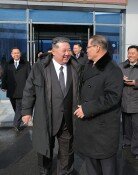Highest intraday won-dollar exchange rate since this year
Highest intraday won-dollar exchange rate since this year
Posted April. 27, 2023 07:52,
Updated April. 27, 2023 07:52
The won-dollar exchange rate spiked up to 1,340.5 during transactions on Wednesday, even going over the highest intraday rate of the year recorded on the previous day. For the first time in five months, the won-dollar rate exceeded 1,340 on Nov. 28 last year. After it was reported that deposits held by First Republic Bank, previously believed to suffer a bank run, sharply dropped, the dollar became temporarily strong to fluctuate the value of the won. Every time the South Korean economy was hard hit by the Asian Financial Crisis, a credit card crisis and the Global Financial Crisis, the won-dollar hovered in the 1,300 range with no exception. Worryingly, there are signs that this trend is becoming a chronic issue.
The Korean won has recently been among the most fluctuating major currencies even as the so-called "King Dollar'' has weakened due to expectations that the brakes will be put on hikes in the key interest rates. For the past month, the Korean won has seen the second biggest drop in value following the Philippine peso among 11 Asian countries. Only the Philippine peso, the oft-defaulted Argentine peso and the ruble of Russia, which is currently in war were devalued more severely than the won during the period.
What's worse, the won that is solely on the decline is mainly attributable to the internal issues that the national economy has suffered. South Korea, one of the major advanced countries with the highest trade reliance, has struggled with a balance-of-trade deficit since last March due to semiconductor issues and decreasing exports to China. Within just the first four months of this year, the country's trade deficit grew to more than 56 percent of the highest yearly record reported last year. According to the Bank of Korea, 40 percent of the drops in the won came from the declines in dollars earned due to slowing exports. As the semiconductor industry, which takes up a fifth of exports, has weakened, it has become obvious that the foundations of the national economy are not strong enough.
Additionally, the Federal Reserve is expected to increase its key interest rates from 4.75-5 percent by 0.25 percent points next month. If the projected U.S. interest hike leads to the biggest gap of 1.75 percent between South Korea and the United States, which has recently frozen its rates twice running due to the slowing economy and household debt issues, a rapid exodus of dollars can happen from South Korea to other markets. Another cause of the weakening won is the delay in the recovery of the Chinese economy which has previously been expected to pick up quickly since the country's reopening. As the yuan of China, South Korea's No. 1 trade partner, has declined in value, the devaluation of the won has aggravated.
A high won-dollar rate was believed to help South Korean exporters gain a price-competitive edge in the global market every time a crisis hit the country. However, it is not the case anymore. Rather, it makes imports of agricultural goods, energy sources, and rare earth elements expensive, which drives up prices to make things hard on South Korean citizens and damage the country’s competitiveness in exports. As the declining won has been caused by the weak fundamentals of the national economy, the key to solving the issue lies in strengthening the economy by making stringent structural reforms and aggressively investing in future growth engines.







